Shomyo, a liturgical Buddhist chant, was introduced from China to Japan in 736 AD. It was influential in the development of Japanese music styles. Shomyo became popular in those days due to the fact that Buddhism, chanting and music worked well together in temples. Shomyo was used in Buddhist ceremonies and services, as a ritual of comfort for the souls of the deceased and as a way to create an atmosphere of reference and mystery. It was also performed in praise of Amida Buddha.
Shomyo is used mainly in the Tendai and Shingon sects. There are two Shomyo styles: ryokyoku and rikkyoku.
Both sects maintained their traditions and used their theory books and notation systems as the basis for newer forms of Buddhist chanting. Shomyo‘s nomenclature and performance practices are found in later Japanese music, much in the way ancient Western art music is based on early Roman Catholic music theory.
Shomyo, like Gagaku, employs the Yo scale, a pentatonic scale with ascending intervals of two, three, two, two, and three semitones.
Continue reading →



